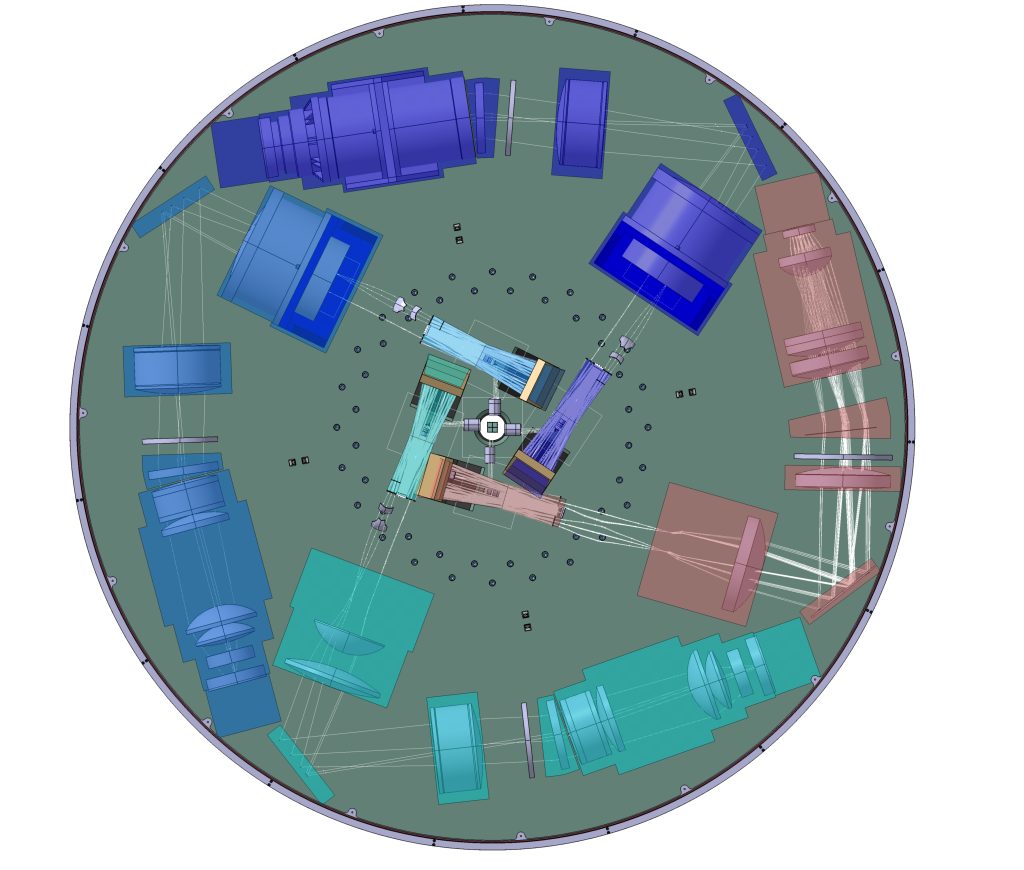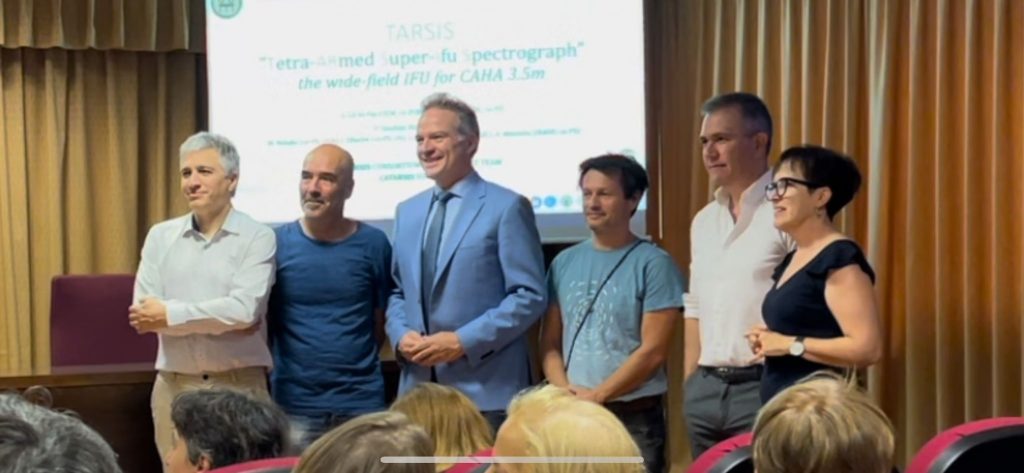TARSIS is the next generation instrument for the Calar Alto 3.5 meter telescope and will be unique in its ability to detect light in the near ultraviolet and its unprecedented field of view.
Armando Gil de Paz, co-principal investigator of the project at UCM, says that TARSIS will be a great challenge because it will obtain information in such a wide energy range and in a field of two-dimensional spectroscopy that is unprecedented in any telescope on the ground or in space.

Design of TARSIS Instrument
The name TARSIS, an acronym for Tetra-ARmed Super-Ifu Spectrograph, refers to its optical design based on four arms, three of them sensitive to blue wavelengths and one sensitive to red wavelengths. The combination of a wide field of view (3×3 square arcminutes) and high sensitivity from ultraviolet (in the range known as UV-A) to red wavelengths will make TARSIS a unique instrument. The design of TARSIS and the transparency of the Calar Alto sky will allow observing in the full UV-A range, a domain almost unexplored from Earth.
“Only the unique features of TARSIS allow us to fully map galaxy clusters at distances where we can still resolve the internal structure of galaxies over a wide energy range,” says Jorge Iglesias, TARSIS co-principal investigator at IAA-CSIC. Armando Gil de Paz, co-principal investigator of the project at UCM, adds that “TARSIS is a great challenge, because obtaining information in such a wide energy range and in a field of this size in two-dimensional spectroscopy is unprecedented in any telescope on Earth or in space. Thus, while classical spectroscopy has only covered a narrow slice of the sky, TARSIS will observe 160 of them”.
Once development is complete, TARSIS will become part of the instrumentation available on the 3.5-meter telescope at the Calar Alto observatory in Almeria. However, during the first years of observations, TARSIS will be mainly dedicated to the CATARSIS project, which will study a sample of sixteen distant galaxy clusters and will reveal earlier stages of the universe: these are galaxies between 20% and 25% less massive than today, but which, on their way to becoming the galaxies we see today, formed stars at a rate three times faster than today. “This is the first time that we have studied the largest and most massive structures in the universe in a systematic way, measuring the velocities of each and every one of the galaxies that make them up, from their center to the outer regions,” says Patricia Sánchez Blázquez, head of science at CATARSIS and member of the UCM Instrumental and Extragalactic Astrophysics Group and the UCM instrument team. CATARSIS observations will help validate the standard cosmological model and understand the nature of dark matter and dark energy, as well as the relationship between the evolution of galaxies and their environment.

Kick off meeting of TARSIS instrument at the University of Almería.
The next 27th and 28th October 2022 will take place, at the University of Almería, the meeting that will start the development of the TARSIS instrument. This project is co-led from the Universidad Complutense de Madrid (UCM) and the Instituto de Astrofísica de Andalucía (IAA-CSIC), in close collaboration with the Calar Alto Observatory (Centro Astronómico Hispano en Andalucía, CAHA), three Andalusian universities (Almería, Granada and Seville), the Centro de Astrobiología (CAB, CSIC-INTA), the industrial partner FRACTAL S.L.N.E. and the Mexican INAOE.
The meeting will be a meeting point for all the team members involved in the development of TARSIS, and also a starting point for the design of the different subsystems that will make up the instrument once its development is completed. In addition, a visit to Calar Alto Observatory is planned so that the entire project team can see where the result of their work will be located.
The construction of TARSIS will be financed through European Regional Development Funds (FONDOS FEDER) and the contributions of the institutions of the consortium in the form of facilities and personnel. The total cost of the instrument is estimated at 7.8 million euros, of which the Ministry of Science and Innovation has already granted Next Generation EU funds to CAHA to launch the project for 1.48 million euros under the public grants for ICTS in the framework of the Recovery, Transformation and Resilience Plan 2021.
Calar Alto Observatory constitutes one of the infrastructures belonging to the map of Singular Scientific and Technical Infrastructures (ICTS), approved by the Science, Technology and Innovation Policy Council on November 6, 2018.
